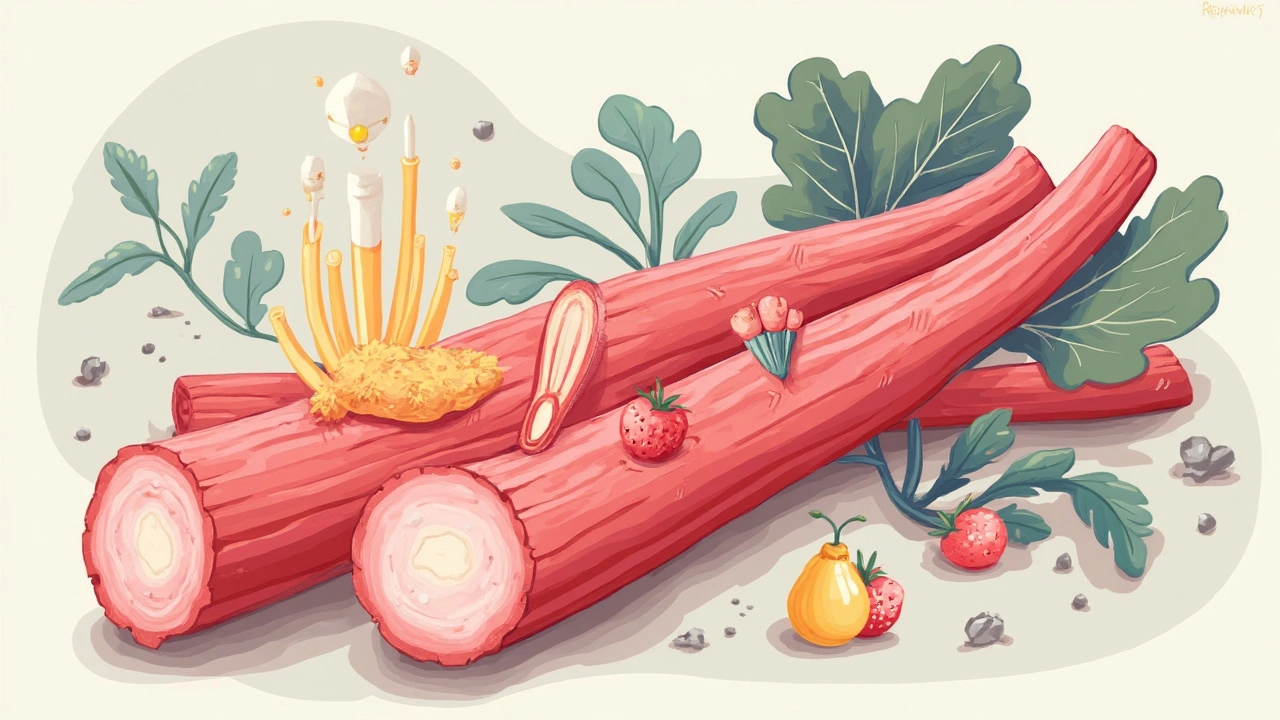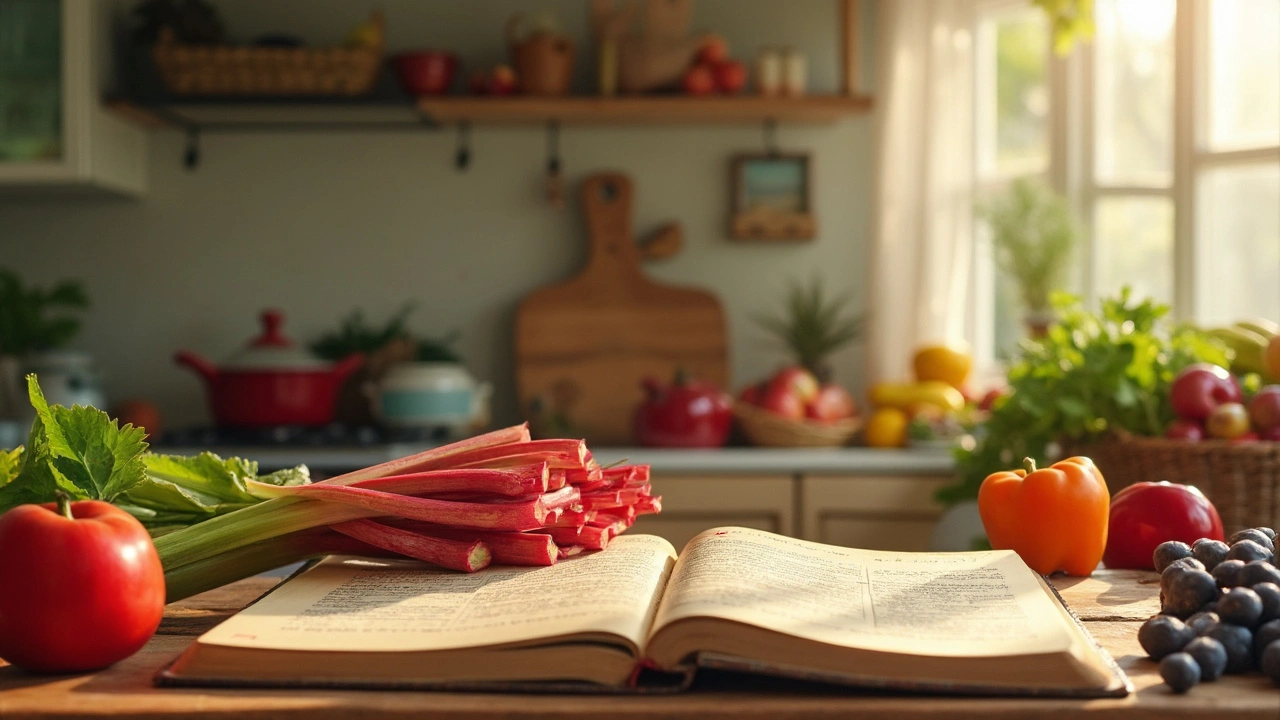Rhubarb isn’t just the tangy stuff your grandma put in pies. It’s like a little secret weapon for anyone looking to up their nutrition game. Loaded with tons of vitamins and minerals, it does wonders for your body while still tasting pretty fantastic. You might think of it as a fruit, but rhubarb is technically a vegetable. And, trust me, it’s way more versatile than you’d imagine.
If you’re curious about ways to improve your health through what you eat, rhubarb should definitely be on your radar. Not only does it pack a punch with vitamins A and K, but it also brings along a bunch of fiber and antioxidants. Ever heard of rhubarb being good for your bones? Yep, it’s true—calcium and vitamin K in rhubarb can support bone health.
Got digestive issues? Rhubarb might help there too. It has components that can keep things moving smoothly, if you get my drift, thanks to its high fiber content. And for those watching their waistline, the low calorie count makes rhubarb an attractive snack or meal component.
- What Makes Rhubarb Nutrient-Rich
- Health Benefits of Rhubarb
- Incorporating Rhubarb Into Your Diet
- Rhubarb Recipes to Try
- Tips for Buying and Storing Rhubarb
What Makes Rhubarb Nutrient-Rich
If you're wondering why rhubarb gets so much attention when it comes to nutrients, you're in the right spot. This red-stalked wonder isn't just eye-catching; it's a nutritional powerhouse. Packed with essential vitamins and minerals, rhubarb can truly complement a healthy diet in many ways.
First off, let’s talk vitamins. Rhubarb is a great source of vitamin K, crucial for blood clotting and bone strength. A cup of diced rhubarb fulfills about a third of your daily vitamin K needs. That's not all—it’s got vitamin C too, which helps keep your immune system in top shape.
Minerals? You bet! Rhubarb boasts calcium and potassium. Calcium is fantastic for keeping those bones and teeth strong, while potassium helps with nerve function and muscle contractions.
For anyone looking to keep their fiber intake up, rhubarb offers benefits in spades. Fiber aids digestion and can help maintain a healthy weight. And yes, rhubarb benefits go beyond digestion—its antioxidants help fight off those pesky free radicals in your body.
Here's a quick breakdown to show how rhubarb stacks up:
| Nutrient | Amount per Cup |
|---|---|
| Vitamin K | 35% of Daily Value |
| Vitamin C | 10% of Daily Value |
| Fiber | 2 grams |
| Calcium | 10% of Daily Value |
So, not just a pie filling, right? Rhubarb crams a lot of good stuff into those crunchy stalks, making it a solid choice for anyone into healthy eating. Next time you see it at the store, grab a bunch and let it work its magic on your meals!
Health Benefits of Rhubarb
Rhubarb might be the unsung hero of dietary supplements. Seriously, this bright and slightly tart vegetable, often confused for a fruit, is packed with good stuff that can actually make a difference to your health. Let's break down some of the awesome rhubarb benefits you'll want to know about.
First up, rhubarb is a champion for your bones. With a good helping of calcium and vitamin K, it supports bone health, making it a handy addition to your meal plan if you're worried about keeping your skeleton in tip-top shape. Did you know that 100 grams of rhubarb contains about 86 mg of calcium? That's pretty cool.
But it doesn’t stop there. The fiber in rhubarb can do wonders for your digestive health. It's one of those natural aids that can help keep your digestion running smoothly. If you're dealing with constipation, the fiber content can help get things moving. Just remember moderation is key, as too much can have the opposite effect.
Rhubarb’s low-calorie count makes it excellent for weight management. You get to enjoy its sweet and sour punch without guilt—perfect for those watching their waistline. Plus, its dietary fiber keeps you feeling full longer, which could be a blessing if you're trying to avoid snacking.
Here's a fun fact: rhubarb is also a great source of antioxidants, like anthocyanins, which give it that snazzy red color. These antioxidants combat oxidative stress in your body. Some folks even believe they have anti-aging effects, though we'll let you be the judge of that one!
| Nutrient | Amount per 100g |
|---|---|
| Calcium | 86 mg |
| Vitamin K | 29.3 mcg |
| Fiber | 1.8 g |
| Calories | 21 |
The more you know about nutrient-rich rhubarb, the more it seems like a pretty awesome addition to a balanced diet. Just keep it prepped right, and it might become a staple in your kitchen. Bon appétit!

Incorporating Rhubarb Into Your Diet
So you’ve heard about the benefits, and now you’re thinking, “How on earth do I actually eat this stuff?” Well, you’re in luck because adding rhubarb to your meals is simpler than pie—no pun intended.
First off, always trim the leaves since they’re not safe to eat. Focus on the stalks, which are the star of the show. You can slice them and toss them in a salad for an extra tangy kick. If you fancy something sweet without the guilt, try stewing rhubarb with a bit of honey or sugar and enjoy it over yogurt or ice cream. That way, you’re making dessert work for you.
If savory is more your taste, consider adding chopped rhubarb to your favorite stir-fry or curry. It pairs surprisingly well with meats like chicken or pork, balancing out flavors with its natural tartness.
For those who love a good smoothie, throw a few pieces of rhubarb into your blender along with your regular fruits and greens. It adds an unexpected twist that’ll make your taste buds do a happy dance.
- Breakfast Boost: Add rhubarb to your oatmeal or cereal for a morning burst of flavor.
- Snack Time: Bake rhubarb with a crumble topping for a healthier snack option.
- Sauce It Up: Rhubarb can be used to make a tangy sauce that works with savory dishes or desserts.
Just remember, a little creativity goes a long way. By mixing nutrient-rich rhubarb into your meals here and there, you can enjoy its benefits without having to overhaul your entire diet. Simple, right?
Rhubarb Recipes to Try
If you're thinking about mixing things up in your kitchen, rhubarb's your guy. It's more than just a pie filler—get ready to be surprised by how versatile this veggie can be in everyday meals. Here are some tasty ideas to get your creative juices flowing.
Rhubarb and Strawberry Smoothie: Want a refreshing and healthy drink? Blend together 2 cups of chopped rhubarb, 1 cup of strawberries, a banana, and a cup of almond milk. Add a spoonful of honey if you're craving a bit of extra sweetness. This nutrient-rich rhubarb smoothie is a game-changer for breakfast.
Rhubarb Chutney: Perfect for jazzing up grilled meats or cheese boards. Start by cooking 4 cups of diced rhubarb with a chopped onion, a teaspoon of ginger, and some spices like cinnamon and cloves. Add half a cup of apple cider vinegar and a bit of sugar. Let it simmer until it thickens. This colorful side dish will steal the spotlight at dinner parties.
Savory Rhubarb Sauce: Move over, cranberry sauce. Combine rhubarb with finely chopped shallots, a cup of chicken stock, and a pinch of salt and pepper. Cook until the rhubarb is soft and the flavors meld together. Pour it over roasted chicken for an unexpected twist.
- Heat a tablespoon of olive oil in a saucepan.
- Add 1 cup of diced rhubarb and stir for 2-3 minutes.
- Add half a cup of chicken stock and season.
- Cook over medium heat for about 10 minutes.
Rhubarb Salad: Toss chopped rhubarb with baby spinach, walnuts, and feta cheese. Drizzle with balsamic vinaigrette for a light, crunchy meal that'll have you feeling good about your food choices.
With these easy recipes, you're not just using rhubarb to enhance your meals—you're reaping the benefits of a nutrient-rich dietary supplement while keeping things delicious and different. Always aim to get fresh, vibrant stalks for the best taste!

Tips for Buying and Storing Rhubarb
Alright, so you want to get your hands on some good-quality rhubarb, huh? Freshness is key here. When you're at the market, look for firm, crisp stalks. They should be a vibrant red or pink—dull colors mean they’ve been hanging around too long. Avoid stalks that are wilting or overly soft.
Once you've got your perfect picks, let’s talk storage. First thing, don't wash the rhubarb until you're ready to use it. Moisture will make it spoil faster in the fridge. Wrap the stalks loosely in a plastic or reusable bag to keep them fresh. Tuck them inside your fridge’s crisper drawer, and they should last about a week.
Thinking long-term? You can freeze rhubarb too! Chop the stalks into pieces, lay them on a baking sheet, and freeze until solid. Then transfer the frozen bits into freezer bags—voila, you’ve got rhubarb ready anytime you fancy a healthy dish.
If numbers help, here’s a quick snapshot:
| Storage Method | Storage Time |
|---|---|
| Refrigerator | Up to 1 week |
| Freezer | 6-12 months |
Remember, the fresher the rhubarb when you buy it, the longer it will last. Picking and storing it right preserves those nutrients and keeps it tasting great. So keep an eye out next time you're grocery shopping!

